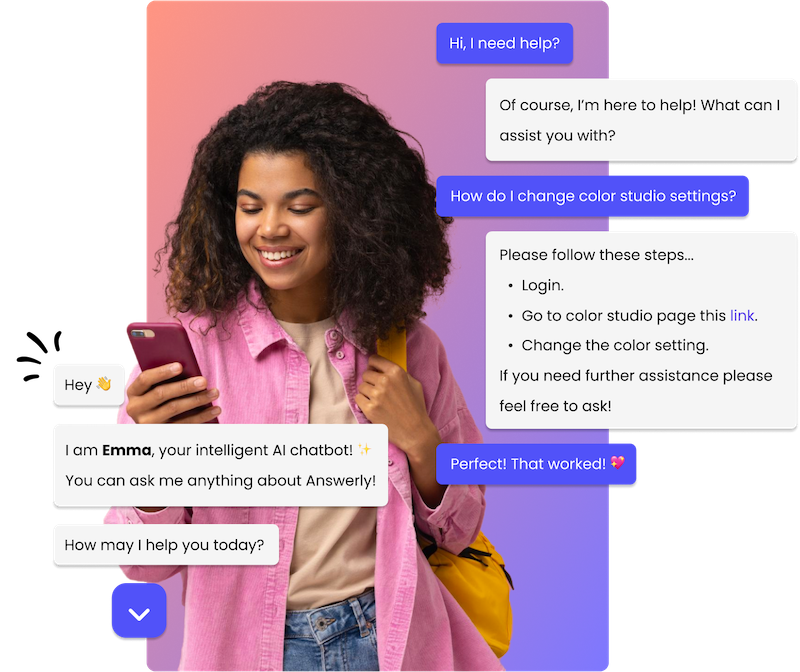Just like a skilled architect crafting a blueprint for a building, you need to carefully plan each step to create an interface that seamlessly engages users.
But where do you start? How do you ensure your chatbot understands user intent, delivers natural language responses, and keeps the conversation flowing smoothly?
In this discussion, we'll unravel the key steps that will guide you through the process, from understanding user goals to testing and iterating for continuous improvement. Get ready to unlock the secrets of designing an AI chatbot interface that leaves users wanting more.
Understanding User Intent and Goals
To effectively design conversational user interfaces for AI chatbots, it's crucial to understand your intent and goals. As a user, you interact with chatbots to achieve certain objectives or seek specific information. Therefore, chatbot designers must grasp your intentions and desired outcomes. By understanding your intent, designers can create chatbots that can accurately interpret and respond to your requests.
One way to understand your intent is through the use of natural language processing (NLP) techniques. NLP allows chatbots to analyze and interpret your queries, enabling them to identify your goals and provide relevant responses. By employing machine learning algorithms, chatbots can continuously learn and improve their understanding of user intent over time.
Another important aspect of understanding user intent and goals is context awareness. Chatbots should be able to consider the context of the conversation and take into account previous interactions to provide more accurate and personalized responses. This can be achieved by incorporating context tracking mechanisms that allow chatbots to retain information and refer back to it when needed.
Designing Natural Language Processing Models
Designing natural language processing models involves several key steps. The first step is data collection and preprocessing. This involves gathering a diverse range of data to train the NLP model, including user queries and corresponding responses. The collected data then needs to be cleaned and preprocessed by removing noise, normalizing text, and handling spelling variations to improve accuracy.
The second step is model selection and training. In this step, an appropriate NLP model architecture needs to be chosen. This could be recurrent neural networks (RNNs) or transformer-based models like BERT. Once the model architecture is selected, the model needs to be trained using the preprocessed data. This involves adjusting hyperparameters and optimizing performance through techniques like transfer learning.
The third step is evaluation and refinement. Once the model is trained, it needs to be evaluated for its performance. This can be done using evaluation metrics such as accuracy or F1 score. The model's performance can then be compared with baselines or human benchmarks. Based on the evaluation results, the NLP model can be fine-tuned. This involves incorporating feedback loops and continuous improvement strategies to enhance the model's performance.
Crafting Engaging Dialogue Flows
Crafting engaging dialogue flows involves designing interactive and captivating conversations that keep users engaged and satisfied with the AI chatbot's responses. To achieve this, it's crucial to structure the dialogue in a logical and intuitive manner.
Start by identifying the main goals of the conversation and map out the different paths that users can take. This helps ensure that the chatbot understands and responds appropriately to various user inputs.
When crafting dialogue flows, it's important to anticipate user needs and provide clear instructions or prompts. Use concise and friendly language that aligns with the chatbot's personality and purpose. Break down complex tasks into smaller, manageable steps to guide users through the conversation smoothly.
To make the conversation more engaging, inject a conversational tone and use natural language patterns. Incorporate small talk, greetings, and expressions of empathy to establish rapport and make the interaction more human-like. Incorporating humor or personalization can also enhance the user experience.
It's crucial to consider the context and personalize responses based on user inputs and preferences. Maintain context throughout the conversation to provide coherent and relevant responses. This can be achieved by using memory and referencing previous user inputs.
Implementing Contextual Awareness and Personalization
Are you wondering how to implement contextual awareness and personalization in your AI chatbot's dialogue flows? These features are essential for creating a more engaging and human-like conversation with your users. Here are some key steps to help you implement contextual awareness and personalization effectively:
- Understand user intent:
- Analyze user queries and responses to identify patterns and common intents.
- Use natural language processing techniques to extract relevant information from user inputs.
- Build a knowledge base to store and retrieve contextual information.
- Maintain conversation context:
- Keep track of previous user interactions to provide a seamless and continuous conversation flow.
- Use session variables to store and update user-specific information.
- Leverage context switching techniques to handle multi-turn conversations smoothly.
- Personalize the conversation:
- Gather user preferences and behavior data to tailor responses and recommendations.
- Use machine learning algorithms to predict user preferences and personalize the conversation accordingly.
- Allow users to customize the chatbot's behavior and adjust its responses to their liking.
Testing and Iterating for Continuous Improvement
To achieve continuous improvement, it's crucial to test and iterate your AI chatbot's dialogue flows. Testing is essential to identify any issues or areas for improvement in your chatbot's conversational capabilities. By conducting thorough testing, you can ensure that your chatbot delivers accurate and relevant responses to user inquiries.
Start by testing your chatbot's dialogue flows in a controlled environment. This involves simulating different user interactions and scenarios to assess how well your chatbot understands and responds to various inputs. By analyzing the results of these tests, you can identify any gaps or weaknesses in your chatbot's conversational abilities.
Once you have identified areas for improvement, it's important to iterate and make necessary adjustments to your chatbot's dialogue flows. This iterative process allows you to refine and enhance the conversational experience for users. Implementing user feedback and continuously testing and iterating your chatbot's dialogue flows will lead to a more effective and user-friendly conversational user interface.
In addition to testing and iterating, it's also crucial to gather user feedback throughout the development and deployment of your chatbot. This feedback can provide valuable insights into user preferences, pain points, and areas where your chatbot can be further optimized. By incorporating user feedback into your iterative process, you can ensure that your chatbot continually evolves and improves over time.
Frequently Asked Questions
How Do I Gather User Feedback to Improve the Conversational User Interface of My AI Chatbot?
To improve the conversational user interface of your AI chatbot, gather user feedback. Listen to their suggestions, analyze their interactions, and make necessary adjustments. Continuous feedback will help enhance the user experience.
Are There Any Ethical Considerations That Should Be Taken Into Account When Designing a Conversational User Interface for AI Chatbots?
When designing a conversational user interface for AI chatbots, it's crucial to consider ethical considerations. Ensure transparency, respect user privacy, avoid bias, and establish clear guidelines to prevent any potential harm or misuse of personal information.
What Are Some Common Challenges Faced When Designing Natural Language Processing Models for AI Chatbots?
When designing a conversational user interface for AI chatbots, you need to consider key steps. These include understanding user needs, designing intuitive interactions, testing and iterating, and always keeping ethical considerations in mind.
How Can I Ensure That My AI Chatbot Understands and Responds Appropriately to User Emotions or Sentiment?
To ensure your AI chatbot understands and responds appropriately to user emotions or sentiment, you can implement sentiment analysis techniques, train the model on emotional data, and regularly update and refine its understanding of different emotions.
What Are Some Best Practices for Conducting User Testing and Iterating on the Design of a Conversational User Interface for AI Chatbots?
To design a conversational user interface for AI chatbots, start by conducting user testing and iterating on the design. Best practices include gathering feedback, analyzing data, making improvements, and repeating the process to create an effective interface.

